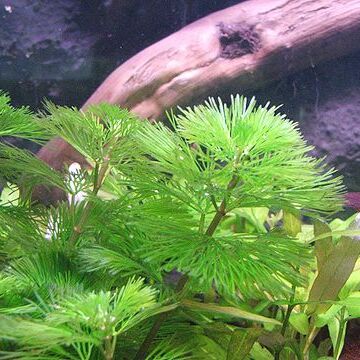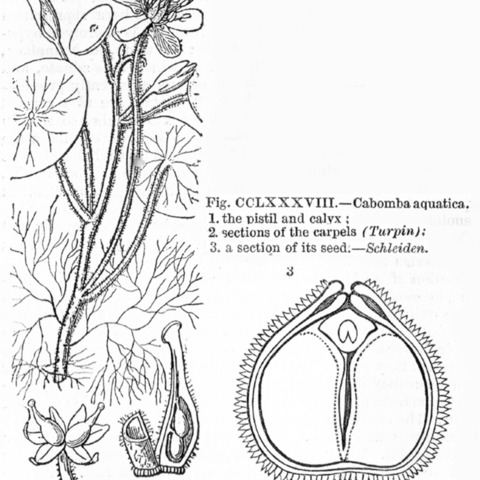Plants with young vegetative parts often rust-colored pubescent, barely mucilaginous. Leaves submersed and floating, short to long petiolate. Submersed leaves conspicuous, basal to apical on stem throughout vegetative period; leaf blade cordate in outline, palmately dissected into dichotomously (trichotomously) branched segments. Floating leaves inconspicuous, alternate, apical on stem only during flowering; leaf blade linear-elliptic or rarely hastate, peltate, base entire or notched. Flowers entomophilous, short pedunculate; perianth showy. Sepals petaloid, obovate. Petals oval, base auriculate. Stamens 3--6, opposite petals. Pistils (1 or)2--4; ovules (1--)3(--5); stigmas capitate. Fruit long pyriform, apically tapered. Seeds ovoid (to subglobose), tuberculate.
Herbs , young vegetative parts often with rust-colored pubescence, barely mucilaginous. Leaves submersed and floating; petiole short to long. Submersed leaves: blade in 3-7 dichotomously [trichotomously] branched, linear segments. Floating leaves: blade terminal, linear-elliptic [broadly elliptic], margins entire or notched at base, appearing only during flowering, inconspicuous [more evident in C . aquatica , a tropical species]. Flowers: sepals 3, petaloid, obovate; petals 3, oval, with proximal, yellow, nectar-bearing auricles, base clawed; stamens 3-6, opposite petals; pistils [1-]2-4, simple, 1-locular; ovules [1-]3[-5]; stigma capitate. Fruits elongate-pyriform, tapered to apex. Seeds ovoid [somewhat globose], tuberculate. x = 13.
Herbs, rooting at stolon nodes and lower nodes of stems. Submerged leaves opposite, or less commonly in whorls of 3, petiolate; lamina circular to kidney-shaped, palmately divided 3–7 times into long narrow primary segments, which may themselves be divided. Floating leaves few or absent, alternate on long petioles; lamina linear-elliptic to broadly ovate or sagittate, not divided into narrow segments. Flowers white, yellow, pink or violet. Sepals 3, petaloid. Petals 3, clawed; base of expanded lamina auriculate, with nectaries in 2 yellow lobes. Stamens 3 or 6; filament slightly flattened. Carpels mostly 2–4, rarely 1–7, free, each with 1–5 pendulous ovules. Seeds covered with elongated processes.
Sep and pet similar, both petaloid; stamens 3–6; anthers extrorse; pistils 3–6; principal lvs opposite, palmately finely dissected, submersed; some small, alternate lvs with floating, entire, peltate blade usually also present. 7, New World.


